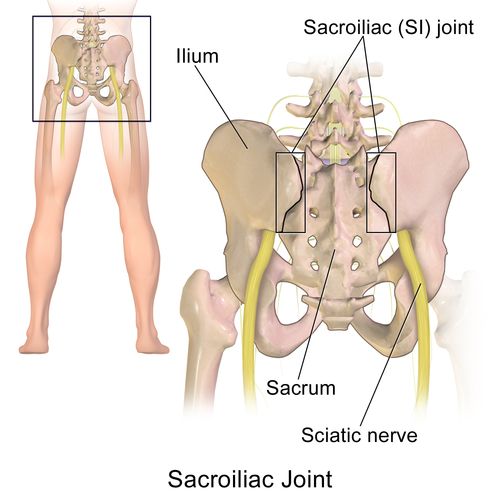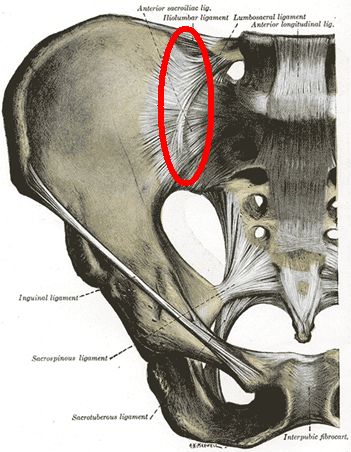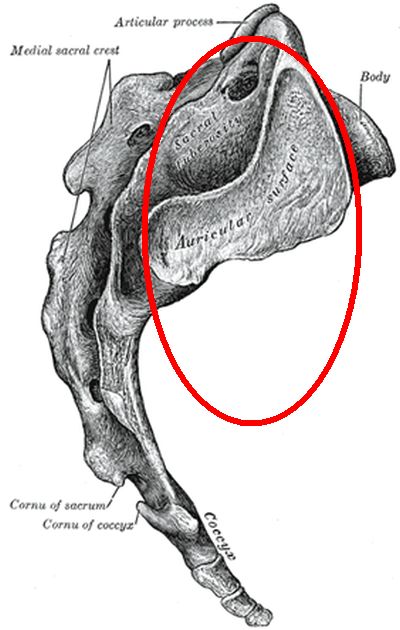The Sacroiliac Joint
Introduction
The sacroiliac joints links the spine to the pelvis and is a major cause of back pain and especially pain in the low back. The sacroiliac joint is lined by synovium and produces lubricating synovial fluid. Synovial type joints are usually very mobile, for example, the hip and knee and many others. However, the sacroiliac joint is different and functions to firmly anchor the pelvis to the lower spine and it has minimal movement.
Indeed this region of the skeleton could easily function as a firm bony bridge without a joint. However, the high stresses acting on the bones at such a location would lead to failure and fracture, hence the need for a joint. Indeed, when surgeons deliberately fuse the sacroiliac joint, the operation may fail due to the high bone stressing at that site.
The sacroiliac joint is most famous in medicine for its association with Ankylosing Spondylitis and the allied Spondyloarthropathies.
The sacroiliac joint is also a common site for mechanical related pains and perceived instability.
Relevant Anatomy
Like the enthesis the sacroiliac joint is lined by fibrocartilage. The opposing surfaces of the sacroiliac joint are not smooth and uniform but irregular or incongruous which limits movement at that site. A detailed anatomy of the joint is shown at the bottom of this page.
Fibrocartilage is a type of cartilage that reflects complex forces are acting on the joint including compression and shearing.
As a result of an identical pattern of mechanical stressing to the underlying bone as that seen at the enthesis, inflammatory diseases of the sacroiliac joint typically start in the bone underneath the fibrocartilage. But disease may also start or involve the actual joint capsule insertion or enthesis or adjacent ligament insertions around the sacroiliac joint.
Diseases of the Sacroiliac Joint-Inflammation related
Ankylosing spondylitis
Psoriatic arthritis-but more typically involves the neck
Reactive arthritis- may be mistaken for infection of "septic sacroiliitis"
Crohns Disease associated sacroilitis
Ulcerative colitis associated sacroilitis
Axial Spondyloarthropathy-a magnetic resonance based rather than X-ray diagnosis
Disease of the Sacroiliac joint- Non-inflammatory
Hypermobility or "Double Jointed"
Degenerative arthritis
Sacroiliac joint ligament Sprain
Hypomobility or decreased or virtually no movement leading to pain in adjacent structures.
Implications of sacroiliac joint disease in ankylosing spondylitis.
It can be very difficult to doctors to distinguish between inflammation and non-inflammation related disorders of the sacroiliac joint. A wrong diagnosis of inflammation could result in the prescription of powerful drugs that may not be effective and also risk serious side effects
Modern Concepts about the sacroiliac joint in ankylosing spondylitis
We now believe that the most typical pattern of early ankylosing spondylitis with disease in the fibrocartilagenous sacroiliac joint rather than the numerous other fibrocartilagenous sites relates to the high level of stressing in the sacroiliac joint.
Indeed UK patients with ankylosing spondylitis have reported to us that injury or vigorous sporting activity may have preceded the onset of ankylosing spondylitis.
What is clear is that exercise helps the spine in ankylosing spondylitis sufferers. This is an area of ongoing research.
Pitfalls in dealing with the sacroiliac joint.
Given its deep location it is physically inaccessible to examination. This is one factor why it has taken doctors up to a decade to recognise patients with ankylosing spondylitis.
The examination of joints strongly relies on determination of the amount of movement. A healthy sacroiliac joint has virtually no movement. Discomfort in adjacent structures including the hip may be a feature of sacroiliac joint disease.
Diseases of the low back including disc degeneration (a type of enthesopathy of the shock absorbers between small back bones called vertebrae) and diseases of the lower back facet joints may cause pain in a similar distribution.
With the complexity of the joint and adjacent structures, pain killing injections into the joint space are difficult and even if they apparently work it does not prove pain coming from this site.
The muscles that move the hip are often anchored near this joint. Discomfort of hip movement may actually be coming from the sacroiliac joint. When in doubt if it pain is coming from the hip or sacroiliac joint or lumbar spine then scan all 3 regions in an attempt to make an accurate diagnosis
In patients with severe instability, surgery remains controversial.
Detailed Relevant Anatomy

|
| This is a cartoon showing the sacroiliac joint from behind. The joint is fairly inaccessible to clinical examination. |

|
| This shows the right sacroiliac joint from the front. The joint space is deep to ligaments and the joint capsule |

|
| This shows the right sacroiliac joint from behind. The joint space is deep strong anchoring ligaments and the joint capsule and is located inside the red box. These ligaments around the sacroiliac joint are a prominent cause of some types of low back pain |

|
| This shows the right sacroiliac joint from the side. Now we can see the cartilage on the sacrum which is the bone region at the bottom of spine. This has an opposing surface also lined by fibrocartilage on the pelvic bone called the ilium. The early problem in ankylosing spondylitis is inflammation in the bone under the fibrocartilage (inside red circle) |
References
 [This now classic study was the first to show that the earliest disease manifestation was in the bone
underneath the cartilages of the sacroiliac joints]
[This now classic study was the first to show that the earliest disease manifestation was in the bone
underneath the cartilages of the sacroiliac joints]
External Resouces.
http://www.spine-health.com/video/sacroiliac-joint-dysfunction-video. An Excellent patient orientated education video about sacroiliac joint